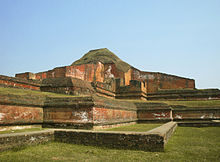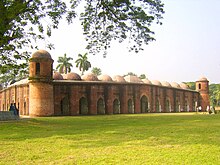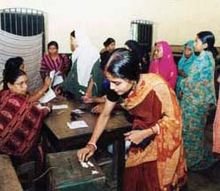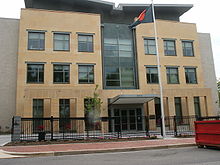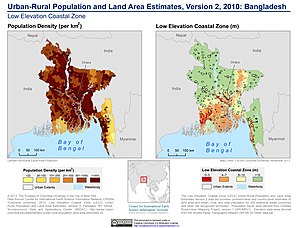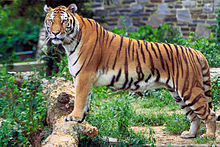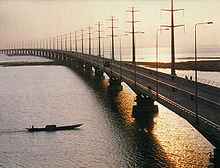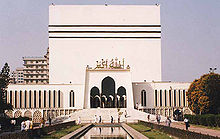Bangladesh
Bangladesh (in Bengali, বাংলাদেশ, tr. Bangladesh, which is the spelling adopted in the Spanish documentation of the UN and the EU), officially known as the People's Republic of Bangladesh (গণপ্রজাতন্ত্রী বাংলাদেশ, tr.Gônoprojatontri Bangladesh is a sovereign country), located in Asia from the south. Its territory is almost completely surrounded by India, except for a small strip to the southeast where it borders Burma. Geographically, the country lies in the fertile terrain of the Ganges delta and is therefore subject to annual flooding from monsoons and cyclones. Together with the Indian province of West Bengal, it constitutes the ethnolinguistic region of Bengal. In fact, in Bengali, the name "Bangladesh" means "country of Bengal."
Its present borders were established with the second partition of Bengal in 1947, when the region became the eastern part of the newly formed Pakistan. However, it was separated from the western part by 1,600 km of Indian Territory. In 1971, political and linguistic discrimination, as well as economic neglect, brought about a series of conflicts with Pakistan, which led to the war of independence and the establishment of Bangladesh as a self-governing nation. After independence, the new state suffered from famine, natural disasters, and widespread poverty, as well as political turmoil and military coups. The restoration of democracy in 1991 was followed by relative calm and slow economic progress.
Bangladesh is the eighth most populous country in the world and the first most densely populated if we exclude some micro-states. Its poverty rate is very high; however, since 1975 its GDP per capita has doubled and the poverty rate has fallen by 20% since the early 1990s. Thus, the country is among the economies of the “next eleven”. Dhaka, the capital, and other urban centers are part of the driving force that has made this growth possible.
The Bangladeshi political system is a parliamentary democracy. In turn, it is a member of the Commonwealth of Nations, the OIC, ASACR, and the D-8. According to the World Bank, the country has made significant progress in terms of human development, in the areas of literacy, gender equity in education, and reducing population growth. However, it still faces a number of significant challenges., including widespread corruption in politics and bureaucracy, economic competition relative to the rest of the world, overpopulation, widespread poverty, unequal land distribution, and the growing danger of a hydrological crisis caused by climate change. It gained independence from Pakistan on December 16, 1971.
Etymology
The word «Bangladesh» (Bangladesh, according to SAR Orthography) is a compound between Bengali, bānglā: "native or belonging to Bengal" and desh, from Sanskrit deśha, "country".
Bangla is a word of Austrian origin and was the name of a Dravidian tribe, known as the Bonga, which gave rise to the Vanga kingdom, on the lower Ganges. The name bonga, of unknown etymology, designated a solar divinity
Islamic tradition attributes the name to a certain Bang, a descendant of Noah and the country's first settler.
Bengali, as a name of a town, appears for the first time at the beginning of the 7th century, while Bangladesh, with the form Vangaladesa, in the 11th century. From the creation of the Sultanate of Bangala, the term was applied to the territory east of the Ganges and was adopted by the Portuguese as Bengala.
History
Before the 20th century
The oldest archaeological remains found in the Bengal region date back four thousand years, when the region was settled by the Dravidian, Tibeto-Burmese and Austroasiatic peoples. The exact origin of the word "Bangla" or "Bengal" is unknown, although it is believed to derive from the Bang, a Dravidian-speaking tribe that settled in the region around 1000 BC. C.
In this area, the kingdom of Gangaridai was formed from the late s. VII a. C., although later it was united with the kingdom of Bihar, to finally be subdued by the empires of Magadha, Nanda, Maurya and Sunga. From the s. III d. C. until the s. VI d. C., Bengal was part of the Gupta and Harsha Vardhana empires. After the latter's fall, a Bengali leader named Shashanka founded a short-lived kingdom in Bengal. In this way, Shashanka is considered the first independent king in the history of Bangladesh.
After a period of disorder, the Buddhist Pala dynasty ruled the region for four hundred years, followed by a shorter reign by the Hindu Sena dynasty. Islam was introduced to Bengal in the s. XII d. C. by Muslim merchants and Sufi missionaries; subsequent Muslim conquests helped spread Islam throughout the region.
In 1204, Bakhtiar Khilji, a Turkic general, defeated Lakshman Sen of the Sena dynasty and conquered much of Bengal. For the next few centuries, the region was ruled by dynasties of sultans and Bhuiyan lords. In the 16th century, the Mughal Empire conquered the territory of Bengal, while Dhaka became an important center of administration mughal
Portuguese
Two decades after the Iberian navigator Vasco Da Gama landed in Calicut, the Bengal Sultanate authorized the establishment of the Portuguese settlement at Chittagong in 1528. It became the first European colonial enclave in Bengal. The Sultanate of Bengal lost control of Chittagong in 1531 after Arakan declared its independence and established the Kingdom of Mrauk U. This altered geopolitical landscape allowed the Portuguese to control Chittagong unimpeded for more than a century. Portuguese ships from Goa and Malacca began frequenting the port city in the 16th century. The cartaz system was introduced and required all ships in the area to purchase naval trade licenses from the Portuguese settlement. The slave trade and piracy flourished. The nearby island of Sandwip was conquered in 1602.
In 1615, the Portuguese Armada defeated a Dutch East India company and an Arakanese fleet off the coast of Chittagong. Since at least 1515 the Portuguese were in Bengal as traders, and later in 1521 an embassy was sent to Gaur so factories could be set up in the region. The Sultan of Bengal after 1534 allowed the Portuguese to create several settlements in Chittagong, Satgaon, Hughli, Bandel and Dhaka. In 1535, the Portuguese allied with the Sultan of Bengal and held the Teliagarhi Pass 280 km from Patna to prevent Mughal invasion. By then a number of the products came from Patna and the Portuguese sent traders, establishing a factory there from 1580.
Products were shipped downriver to other Portuguese ports such as Chittagonon and Satgaoon, and from there to the rest of the empire. Portuguese colonization in Bangladesh and the Bay of Bengal from the 16th centuries to the XIX. By the time the Portuguese secured military aid against Sher Shah, the Mughals had already begun to conquer the Sultanate of Ghiyasuddin Mahmud.
In 1666, the Mughal government of Bengal led by Viceroy Shaista Khan moved to recapture Chittagong from Portuguese and Arakhan control. They launched the Mughal conquest of Chittagong. The Mughals attacked the Arakanese from the jungle with an army of 6,500 soldiers, which was supported by 288 Mughal naval ships blockading the port of Chittagong. After three days of battle, the Arakanese surrendered. The Mughals drove the Portuguese out of Chittagong. Mughal rule ushered in a new era in the history of the Chittagong Territory on the southern bank of the Kashyapnadi (Kaladan River). The port city was renamed Islamabad.
British
European traders arrived in the late 15th century century, and their influence grew until the British East India Company it gained control of Bengal after the Battle of Plassey in 1757. The bloody rebellion of 1857, known as the Sepoy Rebellion, resulted in the transfer of authority to the crown, with a British viceroy taking over administration of the territory During colonial rule, famines plagued the Indian subcontinent many times, including the Great Bengal Famine of 1943, which claimed more than 3 million lives.
From the 20th century
Between 1905 and 1911, an unsuccessful attempt was made to divide the province of India into two zones, with Dhaka being the capital of the eastern zone. When India was partitioned in 1947, Bengal was separated based on religious beliefs: the western part was integrated into India and the eastern part joined Pakistan, as a province called East Bengal (later renamed East Pakistan), with its capital at Dhaka.
In 1950, a major land reform was carried out in East Bengal with the abolition of the Zamindar feudal system. Despite the economic and demographic importance of the eastern part, however, the Pakistani government and military were largely dominated by the upper classes of the western part. The Bengali Language Movement of 1952 was the first sign of friction between the two parts of Pakistan.
Disaffection with the central government over economic and cultural issues continued to grow over the next decade, during which the Awami League emerged as the political voice of the Bengali-speaking population. In the 1960s it called for autonomy for the region and in 1966, its president Sheikh Mujibur Rahman was imprisoned, being released in 1969 after an unprecedented popular uprising.
In 1970, a strong cyclone devastated the coast of East Pakistan, killing more than half a million people, but the central government's response was almost nil. The discontent of the Bengali population grew when Sheikh Mujibur Rahman was prevented from taking office, when the Awami League candidate won a majority in Parliament in the 1970 elections.
After holding negotiations with Mujibur Rahman, Pakistani President Yahya Khan arrested him in the early hours of March 26, 1971 and launched Operation Searchlight, a military assault on East Pakistan. Yahya's methods were extremely bloody and the violence of the war resulted in numerous civilian deaths. The main targets of this operation included intellectuals and Hindus, while around ten million refugees fled to India. Estimates of the victims of the war range between 300,000 and 3 million people dead.
Before his arrest by the Pakistani Army, Mujibur Rahman formally declared Bangladesh's independence and encouraged the entire population to fight until the last Pakistani Army soldier was expelled from East Pakistan. Awami League leaders established a government-in-exile in Calcutta, India. On April 14, 1971, this government-in-exile swore in Mujib Nagar formally as the first president of Bangladesh, with Tajuddin Ahmad as the country's prime minister.
The Bangladesh Liberation War lasted nine months. The eleven-sector Bangladeshi forces were led by General M.A.G. Osmani, while the Mukti Bahini carried out a massive guerrilla war against the Pakistani forces, with the support of the Indian armed forces. On December 16, 1971, this alliance achieved a decisive victory over Pakistan, in which the Indian armed forces took more than 90,000 prisoners of war.
After its independence, the country became a parliamentary democracy, with Mujib Rahman as prime minister. In the 1973 parliamentary elections, the Awami League won by an absolute majority. Between 1973 and 1974 there was a nationwide famine, and in early 1975, Mujib Rahman began a one-party socialist mandate with the BAKSAL alliance. On August 15, 1975, Mujib Rahman was killed along with most of his family members by mid-level military officers.
A series of bloody coups over the next three months culminated in the rise to power of General Ziaur Rahman, who reinstated multi-party politics and founded the Bangladesh Nationalist Party (BNP). Ziaur's term ended when he was assassinated in 1981 by members of the army. The next ruler was General Hossain Mohammad Ershad, who seized power in a peaceful coup in 1982 and ruled until 1990, when he was forced to resign later. of a massive revolt by the main political parties and the public, added to the pressure exerted by some Western countries (due to the great change in international politics after the end of communism).
Since then, the country has been transformed into a parliamentary democracy. Ziaur's widow, Khaleda Zia, led the Bangladesh Nationalist Party to victory in the general election in 1991 and became the first female prime minister in its history. However, the Awami League, led by Sheikh Hasina, one of Mujib Rahman's daughters, clinched power in the 1996 elections, but lost again in 2001 to the Bangladesh Nationalist Party.
On January 11, 2008, following a series of widespread political unrest, a transitional government was appointed to administer the upcoming general elections. The country had suffered a high level of corruption, disorder and political violence. The new transitional government made fighting corruption at all levels of government a priority. To this end, many notable political figures, along with a large number of civil servants and members of political parties, were detained on corruption charges. In this way, the interim government managed to carry out the presidential elections on December 29, 2008. Sheikh Hasina and the Awami League won the elections with a landslide victory and was sworn in as prime minister on January 6, 2009.
In 2017, flooding from a particularly strong monsoon left 140 people dead, some 6 million homeless, 700,000 homes destroyed, 4,680,000 hectares of crops destroyed and thousands of kilometers of roads affected.
Government and politics
Bangladesh is a parliamentary republic. Elections to the unicameral parliament (known as the Jatiya Sangsad) in which all citizens aged 18 and over can vote are held every five years. The parliament building is known as Jatiyo Sangshad Bhaban and was designed by architect Louis Kahn. Currently, the parliament has 345 members including 45 seats reserved for women, elected in constituencies. The prime minister, as the head of government, chooses the members of the cabinet and is in charge of the day-to-day affairs of the state. The president is the head of state and the commander-in-chief of the Bangladeshi army, plus he is elected by parliament. While the prime minister is formally appointed by the president, the latter must be a member of parliament to hold the position.
The president's powers are increased during the tenure of a transitional government, which is responsible for conducting elections and transferring power. The officials of this government must be impartial and have three months to complete their task. This transitional period is an innovation that was pioneered in the 1991 elections and later institutionalized in 1996 through the 13th constitutional amendment.
The Constitution of Bangladesh was drafted in 1972 and has undergone fourteen amendments. The most important judicial body is the Supreme Court, whose judges are appointed by the president. However, judicial institutions and the application of justice are weak. The separation of the judiciary from the executive branch was implemented on November 1, 2007, and it is hoped that with this the legal system will become stronger and more impartial. The laws are loosely based on English common law, but family matters such as marriage and inheritance are based on religious custom, and therefore differ depending on the beliefs of each community.
The two largest political parties are the Awami League and the Bangladesh Nationalist Party (BNP). The BNP is led by Khaleda Zia and its allies include various Muslim parties such as the Bangladesh Jamaat-e-Islami and Islami Oikya Jot, while Sheikh Hasina's Awami League aligns with leftist and secular ideological parties. Hasina and Zia are rivals who have dominated the political scene for more than fifteen years; each one is related to one of the leaders of the independence movement. Another major party is the Jatiya Party, headed by former military dictator Ershad. The rivalry between the Awami League and the BNP has been marked by protests, violence and murder. The study of politics is important among Bangladeshi youth, one of the legacies of the liberation movement era. Almost all parties have highly active student groups, plus some student leaders have been elected to parliament.
In February 2005, two radical Muslim terrorist organizations, the Jagrata Muslim Janata Bangladesh (JMJB) and the Jama'atul Mujahideen Bangladesh (JMB), They were identified and banned. Several small-scale terrorist attacks since 1999 have been blamed on these groups, and dozens of suspected members have been detained in security operations, including the heads of the two sides in 2006. As both leaders were tried and executed, the Bangladeshi government was praised by several world leaders, including some Western leaders, for its strong stance against terrorism.
Elections on January 22, 2007 were postponed indefinitely, and the emergency law declared on January 11, 2007, caused the army to support the caretaker government of Fakhruddin Ahmed, in order to prepare a new list of voters for avoid corruption. The army also assisted the caretaker government in an anti-corruption campaign, which resulted in the country's position in Transparency International's corruption index changing from last place to 147th place in just one year.
On December 29, 2008, a grand alliance led by the Awami League of Bangladesh won the elections with a landslide victory. They won 230 seats out of the 300 available in parliament. On 31 July 2009, Prime Minister Sheikh Hasina expanded the presidential cabinet to a total of 44 ministers.
Human Rights
In terms of human rights, regarding membership of the seven bodies of the International Bill of Human Rights, which include the Human Rights Committee (HRC), Bangladesh has signed or ratified:
Foreign Relations and Armed Forces
Bangladesh follows a moderate foreign policy characterized by heavy reliance on multinational diplomacy, especially the United Nations. In 1974, the country joined the Commonwealth of Nations and the UN, and since then has been twice elected to the UN Security Council: from 1978 to 1979 and from 2000 to 2001. In the 1970s, 1980, played an important role in founding the South Asian Association for Regional Cooperation (SACR) in order to expand relations with other South Asian states. Since SAARC's founding in 1985, a Bangladeshi has held the post of Secretary General twice.
Bangladesh's most important and complex foreign relations are with India, which are deepened by historical and cultural ties, and form an important part of domestic politics. Relations between these two nations began positively, thanks to India's support in the war of independence and in the reconstruction of Bangladesh. Over the years, this situation has changed for a number of reasons. One of the main sources of tension between the two nations is the Farakka dam. In 1975, India built a dam on the Ganges River 18 kilometers from the border with Bangladesh; The latter alleges that the dam diverts much-needed water for Bangladeshis, bringing man-made disaster to the country already plagued by natural disasters, as well as having dire ecological consequences. India on the other hand has raised concerns about anti-India separatists and Islamic militants reportedly harbored on their common 4,142 km border, as well as the flow of illegal migrants and the construction of a fence along most of the border. However, at the 2007 SAARC meeting, both nations pledged to cooperate on security, economic, and border issues.
The current strength of the Bangladeshi army is around 200,000 soldiers including reserves; 22,000 air force pilots and about 14,950 navy conscripts. In addition to traditional defense roles, the The military also come to support civilian authorities in the event of a disaster and to monitor internal security during periods of political instability. Currently, Bangladesh is not active in any ongoing war, but it did contribute 2,300 troops to the coalition that fought the Gulf War in 1991; plus he is constantly a contributor to United Nations peacekeeping forces. As of May 2007, Bangladeshi troops were deployed in the Democratic Republic of the Congo, Liberia, Sudan, East Timor, and the Ivory Coast. Currently, it is the second largest troop contributor to the UN.
Bangladesh enjoys relatively good relations with the People's Republic of China which, particularly in the last ten years, has increased economic cooperation with this South Asian nation. Between 2006 and 2007, trade between the two nations increased by 28.5% and agreements have been made to grant duty-free access to various Bangladeshi products to the Chinese market. Cooperation between the Bangladeshi army and the People's Liberation Army is also increasing, with military deals for Bangladesh to obtain Chinese weapons at cheaper prices.
Territorial organization
Bangladés is divided into 8 (eight) administrative divisions, each named according to the name of its capital: Barisal (বরিশাল), Chittagg (চট্টগ্রাম), Daca (ঢাকা), Khulna (খুলনা), Rajshahi (রাজশাহী), Sylhet (সিলেট), Rangpur (রংপুর) and Mymensingh.
These divisions are divided into districts (zilas). There are 64 districts in Bangladesh, which are further divided into sub-districts (upazilas or thanas). The administration area of each police station, except for those in metropolitan areas, is made up of several unions, which consist of several villages. In metropolitan areas, police stations are spread across neighborhoods, which are divided into mahallas. There are no authorities or elected officials at the divisional, district or upazila level, and the administration consists only of central government officials. However, in each union or neighborhood, local elections are held to elect their representatives to the central government. In 1997, parliament passed a law to reserve three seats (out of twelve) in local councils for women.
Dhaka is the capital and largest city of Bangladesh. Other major cities are Jaitul (Yaitul), Chittagong, Khulna, Rajshahi, Sylhet, Barisal, Bogra, Comilla, Mymensingh and Rangpur. Town council elections are held in these cities, while in other sub-districts only one representative is elected. The mayors and representatives are elected for a period of five years.
Geography
Bangladesh lies in the lowlands of the delta of the Ganges and Brahmaputra rivers, the so-called "Ganges delta". This delta is formed by the confluence of the rivers Ganges (whose local name is Padma or Pôdda), Brahmaputra (Jamuna or Jomuna) and Meghna, with their respective tributaries. The Ganges joins the Jamuna (the main channel of the Brahmaputra) and later the Meghna to finally flow into the Bay of Bengal. The alluvial soil deposited by these rivers gave rise to some of the most fertile plains in the world. Bangladesh has 58 transboundary rivers, making water a politically complicated issue to resolve, in most cases due to conflicts with India. Most of the national territory lies below 12 m s. no. m., and it is believed that around 50% of its territory would be flooded if the sea level rose even one meter.
Since the 1960s, experiments have been carried out in the southeast of the country to build with nature. Through the implementation of a series of cross dams, the natural accumulation of silt has created new land. In the late 1970s, and with Dutch funding, the government began to support the development of this new type of land. The effort has evolved into a multilateral operation to build roads, sewers, embankments, cyclone shelters and ponds, as well as distribute land to peasants. By the beginning of 2010, the program has allocated about 10,927 hectares of land to more than 21,000 families.
The longest beach in the world, Cox's Bazaar south of the city of Chittagong, stretches uninterrupted for more than 120 kilometers. The highest point in the country is in the Mowdok Range at 1,052m. no. m., located in the Chittagong Hill Tracts district, in the southeast of the country.
Climate
Situating on either side of the Tropic of Cancer, Bangladesh has a tropical climate, characterized by a mild winter from October to March and a hot and humid summer from March to June. A monsoon season that runs from June to October supplies most of the country's rainfall. Natural disasters such as floods, tropical cyclones, tornadoes, and tidal waves occur almost every year, and are combined with the effects of deforestation, land degradation, and erosion.
In September 1998, the country suffered one of the worst floods in the history of the modern world. As the country's three main rivers burst their banks, their waters destroyed more than 300,000 houses, 9,700 kilometers of roads and 2,700 kilometers of embankments. 1,000 people died and more than 30 million were left homeless, with 135,000 cattle killed and 50 square kilometers of cultivated land destroyed. In total, two thirds of the country were flooded. There were several reasons for the severity of the flooding: First, there was unusually high rainfall during the monsoon. Second, the Himalayas produced a very high amount of meltwater in that year. Third, the trees that would usually hold back rainwater had been felled for firewood or to make room for livestock.
Bangladesh is now recognized as one of the countries most vulnerable to climate change. Natural hazards brought by increased rainfall, rising sea levels, and tropical cyclones are expected to intensify, each seriously affecting agriculture, food and water supplies, health, and housing. believes that in the coming decades rising sea levels will create more than 20 million climate refugees.
Climate change
According to National Geographic, Bangladés is one of the most vulnerable nations to the impacts of climate change.
Bangladés lies at the bottom of the Ganges, Brahmaputra, and Meghna basins. Bangladés is watered by a total of 57 transboundary rivers: 54 from neighbouring India and three from Myanmar. The country, which has no control of water flows and volumes, drains into Bengal Bay. Along with the high level of widespread poverty and the increase in population density, limited adaptation capacity, and poorly funded and ineffective local administration have made the region one of the most adversely affected on the planet. There are an estimated 1000 people in each square kilometre, with the national population increasing by 2 million people each year. Nearly half of the population is in poverty (defined as a purchasing power parity of US$ 1.25 per person per day). The population lacks the resources to respond to natural disasters, as the government cannot help them.
In the 2017 edition of the Germanwatch climate risk index, Bangladés was judged as the sixth country most hit by the 180 Nations climate calamities during the period 1996–2015.Flora and fauna
Much of the Bangladeshi coastline is comprised of swampy jungle: the Sundarbans, the world's largest mangrove swamp, home to a highly diverse flora and fauna, including the Bengal tiger, the country's national animal. In 1997, this region was declared endangered. The eastern magpie-robin is the national bird of Bangladesh and is commonly known as the doyel or doel (Bengali: দোয়েল). It is a widely used symbol in the country, appearing on banknotes and a landmark in the city of Dhaka is named after 'Doyel Chottor' (Bengali: &# 34;Plaza de Doyel"). The national flower is the water lily and the national fruit is the jackfruit.
Economy
Despite continuing national and international efforts to improve economic and demographic prospects, Bangladesh remains a developing nation. Its 2010 per capita income is US$590, compared to the world average of US$ 10,200. Land ownership is unequal; 60% of the land is in the hands of 16% of the owners; most of the food produced in the country is consumed abroad, due to what has been pointed out as an alliance between landowners and the export industry.
Due to the very low labor costs in the country, given the high poverty rate and low or non-existent social protection, the main multinational textile companies are based in Bangladesh. Since 2005 there have been at least 700 worker deaths from factory fires.
In this way, through Bangladesh labor relations, the drop in wages is known, the elimination of intermediation between employer and worker and full submission to the designs of the former. For this reason, the United States could suspend trade benefits from Bangladesh due to poor working conditions and worker safety.
Jute was once the economic engine of the country. Its export market share peaked in World War II and in the late 1940s it accounted for 80% of export earnings, and even in the early 1970s it still accounted for 70% of export earnings. that figure. However, around the world polypropylene products began to be used as a substitute for jute products, and this industry began to decline. Bangladesh also has significant amounts of rice (chaul), tea (cha) and mustard, all of which are export products.
Although two-thirds of the population is engaged in agriculture, more than three-quarters of export earnings come from the textile industry, which began to attract foreign investors in the 1980s, due in large part to cheap labor and low taxes. In 2002, this industry exported more than five billion dollars worth of products and currently employs more than three million workers, 90% of whom are women. A large part of the country's foreign exchange earnings also come from of remittances sent by Bangladeshis living abroad.
Hardriers to growth include frequent cyclones and floods, incompetent parastatals, aging port facilities, labor force growth that has outpaced the number of jobs, inefficient use of energy resources (such as natural gas), insufficient power sources, slow implementation of economic reforms, political infighting, and corruption. According to the World Bank, "among Bangladesh's most significant obstacles to growth are poor governance and weak public institutions."
Despite these obstacles, according to the World Bank, since 1990 the country has achieved an average annual growth rate of 5%. Bangladesh suffered from the expansion of its middle class and the development of the tertiary sector. In December 2005, four years after its report on the emerging "BRICS" (Brazil, Russia, India, China and South Africa) economies, Goldman Sachs named Bangladesh one of the "Next Eleven," along with Egypt, Indonesia, Vietnam and seven other countries. There has also been a large increase in foreign direct investment in Bangladeshi companies.
The country is home to a large number of large local companies such as Beximco, Square, Akij Group, Ispahani, Navana Group, Transcom Group, Habib Group, KDS and several multinationals such as Unocal Corporation and Chevron, which invest heavily, with the natural gas sector being a priority. In December 2009, the Central Bank of Bangladesh projected GDP growth at around 5.9%.
A major contributor to the development of the economy has been the widespread spread of microcredit by Muhammad Yunus (2006 Nobel Peace Prize laureate), through the Grameen Bank. In the late 1990s, Grameen Bank had 2.3 million members, along with 2.5 million members of other similar organizations. In order to enhance economic growth, the government created several free zones for attract foreign investment, which are administered by the Bangladesh Free Zones Authority.
Many Western multinationals use labor in Bangladesh, one of the cheapest countries in the world: 30 euros a month, compared to 150 or 200 in China. Four days is enough for the CEO of one of the world's top five garment brands to earn what a Bangladeshi garment worker will earn in her lifetime.
In April 2013, at least 1,135 garment workers died in the collapse of their factory. Other fatal accidents due to unsanitary factories have hit Bangladesh: in 2005 a factory collapsed, killing 64 people. In 2006, a series of fires killed 85 people and injured 207 others. In 2010, some 30 people died of suffocation and burns in two serious fires. In 2006, tens of thousands of workers mobilized in one of the largest strike movements in the country, affecting almost all of the 4,000 factories. The Bangladesh Garment Manufacturers and Exporters Association (BGMEA) uses the police forces to suppress the situation. Three workers were killed, hundreds more were shot or imprisoned. In 2010, after a new strike movement, almost 1,000 people were injured among the workers as a result of the repression.
The International Trade Union Confederation cites Bangladesh in 2018 as one of the countries with the lowest levels of workers' rights. He claims that "workers face severe oppression by the state, including violent crackdowns on peaceful protests involving the notorious "industrial police," and intimidation to prevent the formation of unions". There are also massive layoffs of striking workers.
Demographics
Estimates from the International Monetary Fund put the population of Bangladesh at over 167 million, making it the seventh most populous nation in the world. With an area of 148,460 square kilometers, the population density is remarkable. To put it in perspective, the Russian population is slightly smaller despite the fact that Russia has an area of 17.5 million square kilometers, at least 120 times larger than Bangladesh.
The country has the highest population density in the world, excluding some city-states and some small countries such as Bahrain. In the 1960s and 1970s, its population growth was one of the highest in the world, as the country went from 50 to 90 million inhabitants, but with the promotion of family planning in the 1980s, the growth rate slowed. Emigration to more developed countries (especially to the United Kingdom, where there is a large Bangladeshi community) also contributed to the slowdown in population growth. The population is relatively young, as 60% of Bangladeshis are between the ages of 0 and 25, while only 3% are over 65. Life expectancy is 63 years for men and women.
The majority ethnic group is the Bengali people, comprising 98% of the population. The remainder is made up mainly of Bihary migrants and indigenous tribal groups. There are thirteen such tribal groups, situated in the Chittagong Hills, with the most populous tribe being the Chakmas. This region has been a constant source of ethnic conflict since the country's independence.
The largest tribal groups outside this area are the Marma, the Chakma, the Santhals and the Garos (Achiks). There are also the ethnic groups of Kaibartta, Meitei, Mundas, Oraons, Zomi; 52 in all. Human trafficking has been a persistent problem and illegal immigration has led to friction with Burma and India. An agreement was reached in 2017 for the return of Rohingya refugees from Burma.
The official and most widely used language in Bangladesh, as well as West Bengal, is Bengali or Bangla, an Indo-Aryan language of Sanskrit origin that has its own alphabet. English is used as a second language among the upper and middle classes and in higher education. Since an order by the president in 1987, Bengali has been used for all official correspondence except for those addressed to foreign recipients.
Recently, health and education levels have improved, while poverty levels have decreased. Most Bangladeshis live in rural communities, engaging in subsistence farming. Health problems abound, ranging from arsenic contamination of groundwater, to diseases such as malaria, leptospirosis, and dengue fever. High levels of contamination together with poor working conditions in the industrial sector due to the high risk of exposure to toxic and radioactive products have been causing a significant increase in cancer cases in recent years. The literacy rate is approximately 48%. There is no longer a gender disparity as literacy rates have leveled off at 71% for men and 73% for women. Literacy has become a priority thanks to many programs carried out by the local government. Among the most successful are the Food for Education (FFE) program, introduced in 1993, and a scholarship program for women studying at the primary and secondary levels.
The most widespread religion is Islam (89.7%) and a sizeable minority adhere to Hinduism (9.2%). About 97% of Muslims are Sunni, while more than 3% are Shia. Ethnic Biharis are predominantly Shia Muslims. Other religious groups include Buddhists (0.7%, mostly Theravadas), Christians (0.3%, mostly Catholics), and animists (0.1%). Bangladesh is the country with the fourth largest Muslim population., after Indonesia, Pakistan and India, with more than 135 million. Islam is the state religion, but others can also be practiced in harmony.
82% of the population lives in rural areas.
Main towns
Culture
Reflecting the region's long history, Bangladesh has a culture that encompasses elements of old and new. The Bengali language has a rich literary heritage, which is shared with the Indian state of West Bengal. The first literary text in Bengali dates from the s. VIII d. C., the work Charyapada. Medieval Bengali literature was often religious (eg Chandidas), or adapted from other languages (eg Alaol). Bengali literature reached its full expression in the XIX century, among its greatest icons are the poets Rabindranath Tagore and Kazi Nazrul Islam, both however originating from the western part of Bengal, currently belonging to India. Bangladesh also has a long tradition in popular literature, with works such as Maimansingha Gitika, Thakurmar Jhuli and other stories related to Gopal Bhar.
The Bangladeshi musical tradition is lyrically based, with minimal instrumental accompaniment (Baniprodhan). The Baul tradition is a unique heritage of Bengal folk music, plus there are many others that vary from region to region: Gombhira, Bhatiali and Bhawaiya are some of the most popular music genres. Bengal folk music is often accompanied by the ek tara, a single-stringed musical instrument, the dotara, the dhol, the flute and the tabla. Bangladesh also has an active heritage in Hindustani classical music. Similarly, the dance forms stem from folk traditions, especially those of tribal groups, as well as the broad Indian dance tradition.
About 80 films are produced in the country every year, plus major Indian films are also very popular. On August 27, 2016, Under Construction, a film from Bangladeshi director Rubaiyat Hossain, won the Luna de Islantilla Grand Prize for Best Film at the 9th Islantilla International Film Festival (Huelva, Spain), as well as the Luna de Islantilla for Best Actress, which went to the also actress Bangladeshi Shahana Boswani.
About 200 newspapers are also published, along with more than 1,800 other publications. However, there are few regular readers, who make up less than 15% of the population. Bangladeshis listen to a wide variety of local and national radio programs from Bangladesh Betar, as well as four private FM radio stations (Radio Foorti, ABC Radio, Radio Today, Radio Amar) whose popularity among younger generations is growing rapidly in major cities. There are also BBC and Voice of America radio services in Bengali. The dominant television channel is the state-owned Bangladesh Television, but privately-owned channels have developed considerably in recent years. The country's media use Bengali and English interchangeably.
The culinary tradition has close ties to Indian and Middle Eastern cuisine, but also has its own unique characteristics. Rice and curry are the most traditional ingredients. Several very distinctive milk sweets are produced in Bangladesh, some of the most common are rôshogolla, chômchôm and kalojam.
The sari (shari) is the most commonly worn garment among Bangladeshi women. Dhaka, in particular, is famous for the production of exquisite Jamdani muslin sarees. The salwar kameez (shaloar kamiz) is also very popular, while in urban areas some women wear western dress. Among men, the latter is the most used. However, men also wear the kurta-pyjama combination, often on religious occasions; and the lungui, a kind of long skirt.
The two Eids, Eid ul-Fitr and Eid ul-Adha are the biggest festivals in the Islamic calendar. The day before Eid ul-Fitr is called Chãd Rat (the night of the moon) and is usually celebrated with fireworks. Other Muslim holidays are also celebrated in the country. The biggest Hindu festivals are Durga Puja, Kali Puja and Sarasvati Puja. Buddha Purnima, which commemorates the birth of Buddha, is one of the most important Buddhist festivals, while Christmas, called Borodin (big day) in Bengal is celebrated by the Christian minority. The most important secular festival is Pohela Baishakh or New Year, the beginning of the Bengali calendar. Other festivities include Nobanno, Poush parbon (Poush festival) and various national days such as Shohid Dibosh.
Sports
Kabbadi is the national sport, although cricket is most popular, closely followed by soccer. The national cricket team first participated in a world championship in 1999. Since then, they have defeated other powerhouse teams in the sport, including Pakistan, Scotland, Australia, New Zealand, Sri Lanka, the West Indies, South Africa and India. For its part, the Bangladeshi soccer team, both women's and men's, has never managed to qualify in a World Cup. Bangladesh has participated seven times in the Olympic Games, without obtaining any medal.
Other popular sports include field hockey, tennis, badminton, handball, volleyball, chess, shooting sports, and carrom games. The Bangladesh Sports Board regulates the twenty-nine different sports federations. In 2011, the country co-hosted the Cricket World Cup with India and Sri Lanka.
Its soccer team, on the other hand, is currently one of the worst in Asia, although in its history it has had great achievements, such as having qualified for the 1980 Asian Cup, its only classification so far, or obtaining the Cup Gold of the SAFF 2003. Within the country, there is the Premier League of Bangladesh, which was founded in 2007 and the most winning team is Abahani Limited Dhaka, with 7 titles.
Trafficking in girls and women
In Bangladesh there are huge brothels that, surrounded by high walls, function as true prisons for girls and women who are sexual slaves. In those places, hundreds of girls are born and die without having known freedom, girls who were stolen from their homes, recruited under deceit in the streets or used as bargaining chips to pay debts. There they will have to pay fictitious and oversized debts with forced sexual services to recover an illusory freedom that will never be a reality for them, since once they are free, they have no space to insert themselves into an outside world that despises and stigmatizes, forcing them to return to the same way of life In these brothels built by the British during colonial rule there are thousands of girls who are forced to take steroids and all kinds of drugs to make them appear older and be docile to the sexual violence to which they are subjected. In Dautladia, for example, 90% of the 2,000 girl sex slaves have used steroids, brutally damaging their livers and kidneys; many of them are addicted to heroin. Built by the British during colonial rule, this brothel is now owned by the family of a local politician who benefit from the area's growing economy. Another well-known brothel that exploits child sex slaves is the walled brothel of Kandapara, in Dhaka, the oldest in the country. There the abducted girls exercise first sexual slavery and then prostitution. Only a few girls manage to get out of this degrading circle thanks to an NGO managed by BRAC (Bangladesh Rural Progress Committee), which settled in the vicinity of the place to provide free education to the daughters and sons of prostitutes. [citation required]
Child labor
In 1992 child labor was outlawed. In 2001, the government ratified Convention 182 of the International Labor Organization on the prohibition of the worst forms of child labor and immediate action for its elimination, and agreed to be guided by the abolitionist recommendations of the international community.
However, according to the 2003 public survey on child labor, the International Labor Organization estimated that there were 7.9 million child laborers in Bangladesh working full-time, non-stop, in subhuman conditions. 93.3% work informally for salaries of between 10 and 20 euros per month; 700 taka is about 10 dollars while an adult worker earns up to 5,000 for the same job. Mostly 6.4 million lived in rural areas and 1.5 in urban areas.
Contenido relacionado
9th century
Geomorphology
Kingdom of macedonia
